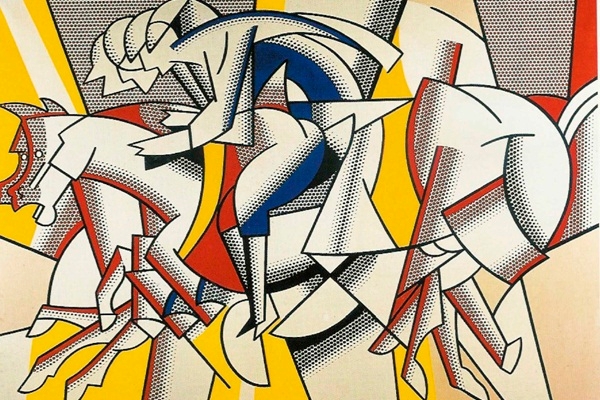Tate Modern promises that its forthcoming retrospective will showcase ‘the full scope of Roy Lichtenstein’s artistic explorations’, to which Spectator art critic Andrew Lambirth responded acidly: ‘I look forward to being pleasantly surprised.’ And it’s true that once Lichtenstein perfected his dot patterning technique in the mid-Sixties, he stuck with it until his death more than 30 years later. Alastair Sooke’s How Modern Art Was Saved By Donald Duck is available as a Penguin Specials paperback from Tate Modern; elsewhere, it’s in eBook format only. It won’t convince any sceptics of Lichtenstein’s infinite versatility, but it does make a case for him as a supreme examiner of style.
‘Perfected’ is the word for Lichtenstein’s technique, as his experiments with frottage meant his earliest works in dot patterns still bore some trace of the artist’s hand. Only once any painterly element had been removed was his revolt against Abstract Expressionism complete. It’s unfortunate that Lichtenstein’s early comic book enlargements are the works that fetch astronomical prices at auction, as he swiftly evolved beyond them to engage instead with art history. Picasso’s fruit bowls, Monet’s haystacks, Dali’s melting faces: all were candidates for the dots, stripes and primary colours treatment. He then went a stage further, and these ‘Lichtensteinized’ masterworks started appeared hanging improbably on bedroom walls in paintings of ordinary domestic settings. A postmodern approach to dealing with the burden of art history? Sooke highlights Lichtenstein’s defence that ‘the things that I have apparently parodied I actually admire’, and it’s telling that he recreated Monet’s Rouen Cathedral series in broadly the same way as he did a bubblegum wrapper. In doing so, was he trivialising masterworks, or elevating the mundane? If you accept Sooke’s compelling thesis that ‘his enduring subject was style’, Lichtenstein was doing neither.
Sooke does an excellent job of teasing out the satirical aspects of Lichtenstein’s work, recasting 1961’s pugilistic ‘Popeye’ as a punch on the nose for the Abstract Expressionists then dominating American art, or maybe even as an abstract work itself. He further mocked the gestural spontaneity of Pollock et al by placing gigantic, painstakingly rendered brushstrokes against a background of those ubiquitous dots. This fastidious, mechanistic method of creation (‘I want to hide the record of my hand’) actually places Lichtenstein closer to minimalists like Donald Judd than the other Pop artists.
Yet this strategy could be said to have backfired. Unlike Warhol’s proud displays of Brillo boxes and Campbell’s soup tins, Lichtenstein’s works were as free of specific brands as they were of distinctive brushwork. But so recognisable was his style that each painting became a branded item, whether based on Mickey Mouse or Matisse. Such are the risks of an exhaustive inquiry into style itself.
It was Rodin’s curse to be best remembered for his least representative work. While Lichtenstein might be the lesser talent in the eyes of the art establishment, Sooke leaves us in no doubt that there was more to him than exploding fighter planes. Hit the Tate from 21 February for the proof.






Comments